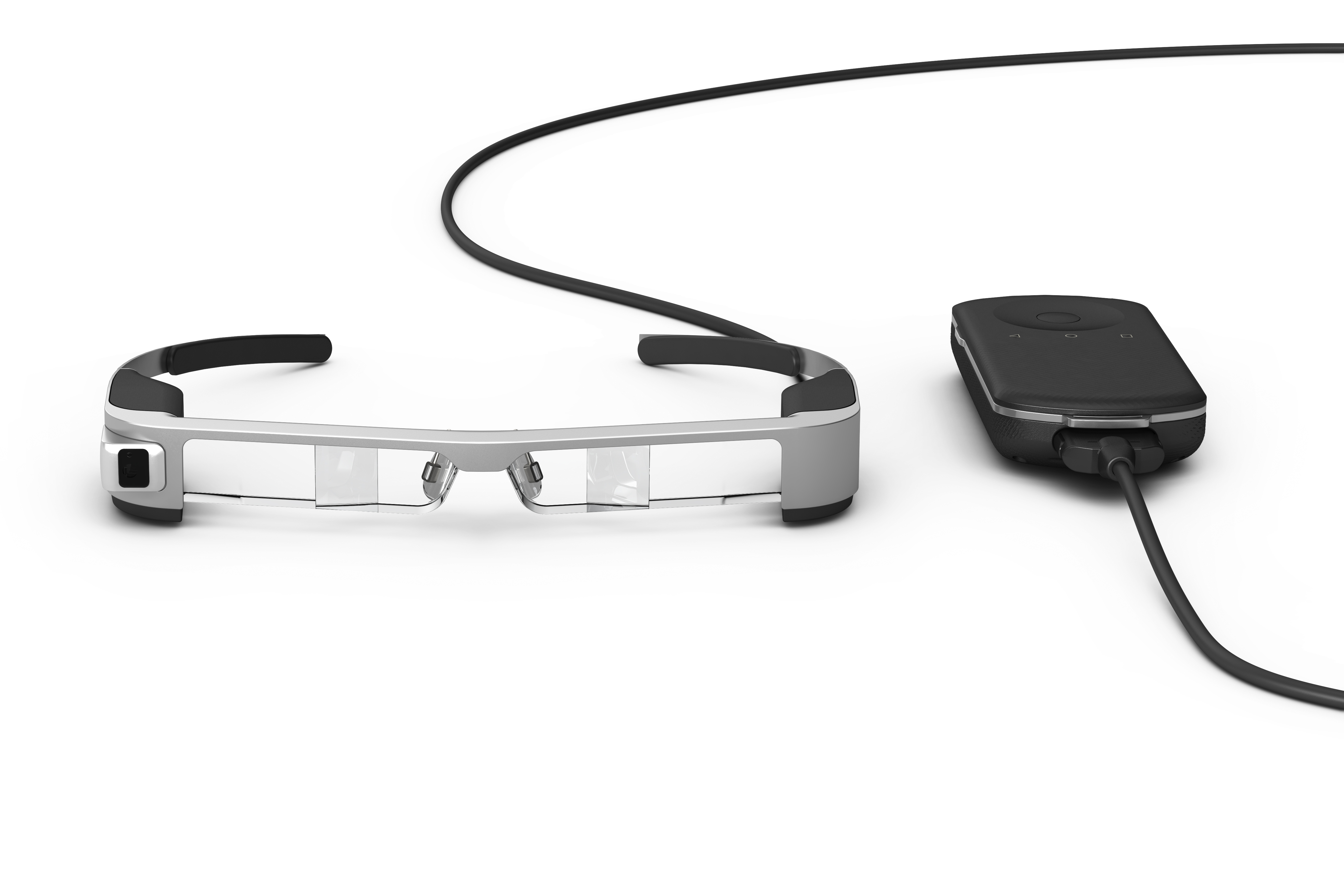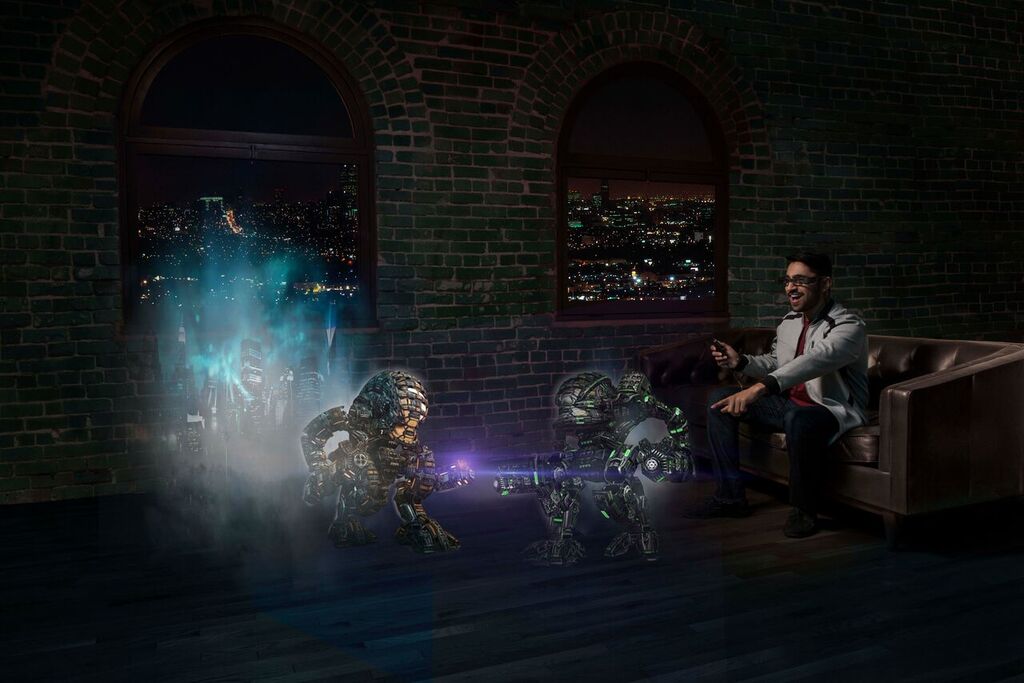Epson Announces Moverio BT-300 Augmented Reality Glasses, Big Improvements
With VR practically upon us, it’s easy to ignore its kissing cousin, AR, or augmented reality, which partially reared its head in the latest round of HTC Vive, and which seems to hold promise as an added feature of VR. Yet AR simply by itself is still very much a thing, and a very exciting one, even if its applications are perhaps more esoteric and niche in comparison.
One of AR’s early purveyors is Epson, manufacturer of printers, yes, but also projectors (see the fit?). I reviewed Epson’s Moverio BT-200 more than a year ago, and while I found the concept fascinating, the product itself was frustrating and lacking. It was clunky, heavy, intrusive, and its resolution was poor.
Even back then I got hints that Epson was working on future efforts, and finally back at CES I got an early and brief look at the working prototype of the next version of the Moverio, the BT-300. Today, here at Mobile World Congress in Barcelona, Epson is taking the wraps off the BT-300, even if we’ll have to wait a few months before it actually ships.
The short version is this: it’s no longer clunky, heavy, or intrusive, and its resolution is like the first time I was ever forced to try on a pair of glasses for my deteriorating eyesight. In short, the world of AR suddenly became clearer. The prototype I tried at CES was quite fragile, but Epson's product manager, Eric Mizufuka said that the new versions the company is showing off here in Barcelona are much sturdier and ready for the rowdy crowds.
Perhaps the biggest change is a shift from the LCD-based glass display (at a meager QHD resolution) to a custom silicon OLED projection based panel, which should provide more responsiveness, more brightness (the BT-200 measured 1050cd/m2, the BT-300 1200cd/m2), better contrast (it goes from 230:1 in the BT-200 to 100,000:1 in the BT-300), a wider color gamut (90% NTSC vs the 52% for the BT-200), and more visual precision, as well as more efficient power usage. The resolution is now 720p (or 1280x720).
In my short experience with the BT-300, the display improvement was a monumental change. Gone is the ghosting you normally see in many AR experiences. These are still binocular glasses, with a 23 degree field of view. When I tested the BT-200 I tried actions that required some precision part placement (a detailed Lego helicopter) and color matching, and it turned out to be a headache-inducing exercise with many failures along the way, primarily because of the lack of image clarity (and particularly color matching). I can't wait to try something like that again with the BT-300.
Another significant change takes place in the control unit. The one with the BT-200 was equipped with a TI OMAP 4460, an older dual core processor running at 1.2 GHz, with 1GB of RAM and 8GB of internal storage. It ran Android 4.04. The BT-300 uses a quad core Intel Atom X5, running at 1.44GHz, using Android 5.1. As you can see from the image at the top of this page (and in comparison to the one directly below, which is the BT-200), the controller has also changed. I found the BT-200 controller extremely frustrating as a touchpad. While I didn't have much time with the one that comes with the BT-300 it is certainly sleeker and more ergonomic. It has a touchpad on the bottom and a directional pad and a selector at the top. It's truly more of a powerful Android controller than a crippled smartphone.
Get Tom's Hardware's best news and in-depth reviews, straight to your inbox.
The BT-300 glasses and controller are also lighter than those of the BT-200 (pictured directly above). The glasses are 20% lighter, according to Epson. The BT-200 glasses weighed 88g and the BT-300 will weigh in the 60g+ range -- the final weight is yet to be determined. The same goes for the dimensions.
The front facing camera is now 5MP. The one on the BT-200 was a meager VGA camera (or .3MP). In the BT-200, the camera was really more of an image sensor and drew very little power -- in other words, it wasn't needed for much. While the camera’s role as an image sensor (detecting objects in the real world) hasn’t changed, Epson did want to improve it for some of the applications that have been built for the Moverio. For example, remote support, Drone control, and even remote viewing experiences like those from GoInStore.
The BT-200 included a GPS and compass in both the headset and controller, a gyroscope and an accelerometer, and all of those are in the BT-300, and improved, we're told. Battery life remains the same (6 hours), and WiFi capabilities are better (the BT-200 supported 802.11b/g/n at 2.4 GHz, and the BT-200 adds 802.11a and 802.11ac and supports both 2.4 GHz and 5 GHz). Head tracking performance hasn't changed; the BT-200 polled the gyro at 60fps, and since this isn't VR the head tracking performance doesn't have to be as high, according to Epson.
Epson has worked across industries to build use case partnerships, according to Eric Mizufuka, Epson’s product manager for new ventures. “In addition to pursuing new markets for our technology, we will rapidly scale in areas where we’ve had commercial success, including drone photography, remote support, AR training/maintenance, healthcare, retail, logistics and more.”
The BT-300 will be available later this year and Epson is currently taking pre-orders here. The BT-200 was $700 and the BT-300 will be around the same price.
Fritz Nelson is the Editor-In-Chief of Tom's Hardware. Follow him on Twitter, Facebook and Google+. Follow us on Facebook, Google+, RSS, Twitter and YouTube.
-
DrakeFS First we have the Bluetooth headset, which makes it socially acceptable to always be talking to yourself for no apparent reason. Now we have AR glasses that will apparently make the user point at nothing, randomly... How are we supposed to tell the crazy ones from the sane ones now?!?!Reply -
Adilaris ReplyFirst we have the Bluetooth headset, which makes it socially acceptable to always be talking to yourself for no apparent reason. Now we have AR glasses that will apparently make the user point at nothing, randomly... How are we supposed to tell the crazy ones from the sane ones now?!?!
Whether or not they have a very visible contraption on their face is usually a good giveaway if they're using it.



